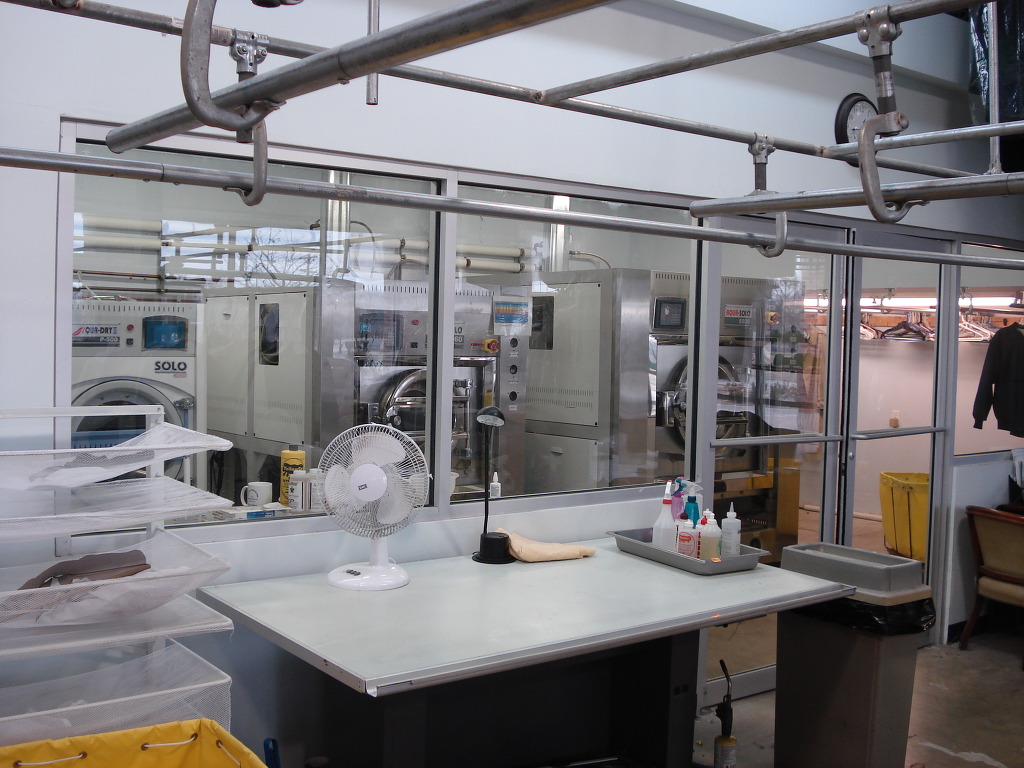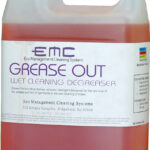The most frequently asked question about wetcleaning is how to remove oil stains. I have always emphasized that wetcleaning spotting is much easier than drycleaning. However, many cleaners hesitate to start wetcleaning for fear of oil stains. But to a seasoned wetcleaner, oil stains are not an obstacle at all. So, let’s talk about oil stains this month. I have written this column a couple of times before but I am reposting this column since I receive so many questions about it.
Why wetcleaning spotting is so easy
The reason why wetcleaning spotting is so much easier is the fact that 95% of stains are wetside stains. Coffee, juice, deodorants, sweat, albumin, dirt all come off easy in water. Oil stains like lipstick, cosmetics or ink can be removed by wetside spotting chemicals. It doesn’t take too much time to remove them, either. You don’t even have to vacuum or air dry first before tossing them into the washer. That is why wetcleaning spotting is so easy and fast. In my store, the spotting table doesn’t even have a vacuum connection. It takes about 10 minutes to spot around 50 pieces. Of course, the spotting time varies but it never exceeds 15 minutes.

Another reason why wetcleaning spotting is so much easier is the fact that the spotting board is rarely used. As you can see in the picture, I use a big table for spotting. I use the spotting board for stains like ink, paint and glue so it doesn’t happen very often. Since I stack many pieces on the table, the efficiency is very high. Spreading the piece on this big table allows me to do a quick inspection.
When you use steam and air on the stain, you can’t help but breathe some of the chemicals. Since I seldom use them, the working environment is very safe and healthy.
Even though wetcleaning spotting has so many benefits, beginners fear oil stains. It is true drycleaning is better at removing oil stains. Some drycleaners dryclean first and then wetclean remaining oil stains. Let me show you how I handle oil stains:
1. Local spots
When the stain is small, I use Grease Out (Aqua Master brand with citric oil) solution (1 to 1 with water). I sometimes use Grease Out full strength. Apply to the oil stain, tamp lightly, wait 30 minutes to an hour before washing. If the color is safe, leave it overnight. Chemicals like bleaches and rust removers work instantly but an oil remover needs time to work. I treat about 70% of oil stains this way.

2. Bath method
If oil stains are too many or large, local spotting will take too much time. In this case, I soak them in Grease Out solution. Add about 2~3 oz. of Grease Out to 1.5 gallon of water. Depending on the stains and color, soak it for 1~2 hours or overnight. It takes more time but works very well.
One of my regular customers is a cheese factory supervisor. His shirts are literally covered in oil. I just soak them in Grease Out solution and I have a clean result every time.
Bath method has other uses, too. If you have a dark silk blouse with local color loss from spotting, you can soak it to correct it. You have to closely monitor the progress to prevent too much color loss. Add 2~3oz. of a conditioner for better result in the final rinse. This is particularly effective for Tommy Bahama silk shirts.
3. Oil remover spray
You should be able to handle over 90% of oil stains with above methods. But sometimes oil stains are discovered only after pressing. To avoid rewashing, I use an oil remover spray. Spray the stain, it turns white, then blow with air. It is very effective. I’m sure every drycleaner is familiar with this product. Just be careful when you use it and avoid breathing the blown powder.
An oil remover spray used to dissolve acetates but now, its safety is greatly improved. Of course, a safety test will never hurt.
Above mentioned methods will take care of almost all the oil stains. Oil stains are not many since most stains are wetside. It takes a little bit of attention to take care of them.
Oxidized oil stains
The difficulty of an oil stain increases with time. If an oil stain is only days old, its removal is not an issue. But if it is several months or even years old, even drycleaning won’t remove it. When an oil stain receive heat or combine with oxygen in the air, it oxidizes and chemically changes.
Most oxidized oil stains appear yellow and sometimes feels stiff. Especially in shirts laundry, oil stains pressed with hot plates oxidize rapidly and become almost impossible to remove.
You can soak such stain in hydrogen peroxide and soap solution. Or if it’s white, bleach solution. Not many options with colored fabrics.
You can use a special alcohol solution for oxidized oil stains. Before using this solution, make sure to remove all the chemicals and moisture. This solution is called KOH (potassium hydroxide solution). You can buy it online or make it yourself. Using KOH involves a great danger and the chance of damaging the fabric is very high. I would rather recommend a product like TarGo even though it is not as effective.
With an oxidized oil stain, do your best but know when to stop. When an oil stain oxidizes, the chance that the fabric is also weakened is very high. It is no exception for a drycleaner. Most customers do not have a high expectation with this stain so don’t try too hard. A good spotter should be aware of the Murphy’s Law at all times.

Yangsoo Kim
The author is the developer of Aqua Master wet cleaning chemicals and is currently operating Green Life Cleaners, a 100% wet cleaning service. You can contact him by phone (201) 699-7227 or email at yangkim50@gmail.com.

